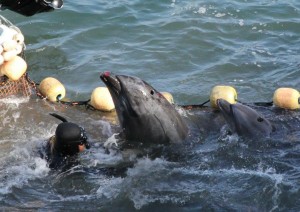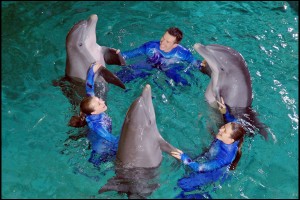Animal Welfare Issues
STRESS
Scientific research shows that a dolphins health and immune system function are crucially compromised during stress when being captured and chased. Stress also has a negative impact on reproductive success. During the prolonged capturing, waiting and slaughtering process of dolphins during the annual dolphin drive hunt, the dolphins exhibit great amounts of stress. The distress transfers to those that are able to escape from being slaughtered and that are able to swim back into the wild. The psychological responses such as, fear and physiological responses such as, overexhaustion and overheating can hide in metabolic processes that can cause detrimental damage to the kidneys and heart in the dolphin. These unhealthy responses in the biological pathways may lead to future deaths.
A group of dolphins stressed in the cove, trying to escape
In very proximity to each other
DISRUPTION IN PODS SOCIAL STRUCTURE
The social structure of the pods of dolphins are ultimately destroyed, while family members watch other family members get slaughtered. It is known that dolphins are sentient beings and are able to feel emotion and grieve towards another. Especially when a mother loses her calf, she will observingly scream out in pain and discomfort as her baby calf is separated from her. Dolphins carry strong social bonds between members of the groups and when separated this bond will be broken and secondary suffering may occur.
Injured and defenceless mother dolphins puts herself between the trainer and child
INJURED DOLPHINS
A small amount of dolphins that happen to get injuries on their beaks, dorsal fins or pectoral fins may drown in the cove and suffer the most because of the agonizing pain from the wounds until death.
A lone striped dolphin awaits its fate in the nets at the Cove in Taiji
Five Freedoms
The five freedoms was developed by the Farm Animal Welfare council in the United Kingdom in 1993 to consider the basic needs of animals. They were conducted to minimize the pain and suffering in the agricultural use of animals. Dolphins are gathered for their meat as food in the dolphin drives and so the five freedoms can be defensibly relevant in which the slaughterings should be measured.
1) freedom from thirst, hunger and malnutrition 2) freedom from discomfort 3) freedom from pain, injury, and disease 4) freedom from fear and distress, and 5) freedom to express normal behaviour
Humane Slaughter Act (HSA)
The Humane Slaughter Act was created in the United States in 1958 with the purpose of making sure that every animal slaughtered for human consumption is killed in the most humane way possible: stunning the animals before being killed.
The Japanese drive hunts obviously do not meet the standards that are applied in modern societies for agricultural animals.
Why?
Animal Welfare Concerns
a. The dolphins are dragged by their flukes to the shore of the cove by the fishermen tethering them with rope to the boat. The dolphins cannot swim anymore and are pushed underwater over and over again. Many people are aware that dolphins are like humans and have to take conscious breaths to survive and cannot stay underwater for too long. They are undergoing constant pressure from the other dolphins that are tied up alongside them and from trying to escape. These factors are going to cause distress in these creatures and some may even experience forced asphyxiation due to the inability to control their breathing.
b. The dolphins are in very close proximity during the capturing and slaughtering processes. It is known that dolphins are social cetaceans who have long interdependent relationships with each other, living in complex social groups. They are also intelligent, cognitive creatures and are self-aware with themselves and aware of their surroundings. The brutal culling process involves being hauled into a small cove where there is no food and are forced to wait numerous hours to meet their fatal death.
c. The method that is used to decide the dolphins’ deaths’ is, the ending of movement, when killed by the severing of their spinal cords. This is not a credible measure of death though and many animals could suffer by the incomplete severing of their spinal cords resulting in a longer time of death.
d. The termination of breathing as a determinant of death is also not a credible measure in these mammals because they are able to hold their breath for up to 10 minutes or longer. Fishermen have claimed that dolphins have stopped breathing after as little as 8 to 25 seconds. This is highly unlikely because these times are very short for a mammal that has a capacity to hold its breath for very long periods of time.
e. Fishermen are continuously stabbing the dolphins with a metal rod behind the blowhole and the dolphins are evidently convolving and making vigorous movements even when the rod is removed. This shows that the death of the dolphins by use of the present method does not result in immediate death in these highly cognitive creatures. When a wooden wedge is driven into the wound, the dolphins are still continuing to make rigorous movements and are clearing internally bleeding. This leads to distress in the animals that are still aware of their surroundings because of the brain still being intact and functioning. After what seems like an eternity, the dolphins becomes paralyzed and dies from trauma and slow blood loss.
f. Dolphins that are dragged out of the water for inspection will suffer from internal organ dysfunction because they are used to being in the water where their bodies are buoyant and float easily. The pressure exerted on either side of the dolphin will crush the organs.
Dolphins are similar to humans
Dolphins are very similar to humans, more than we thought in the past. These highly social mammals are warm blooded, need air to breathe and lactate their children after birth. They have mutual emotional and cognitive characteristics close to that of humans. They share social complexes that are even perplexing to humans and these annual Taiji dolphin drives are clearly impacting these complicated animals.




